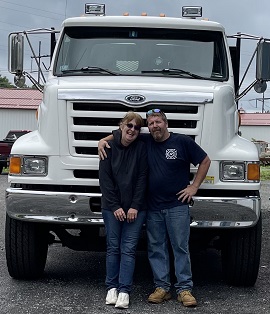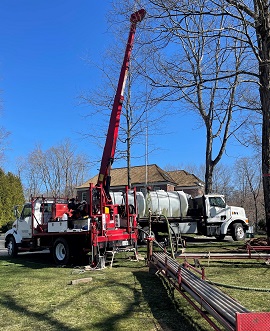As water well hydrofracturing veteran Jim McDonald, CWD, announced his intentions to retire last year, Daniel Boyd jumped at the chance to purchase the equipment and tooling side of his company, Starr Hydro Inc.
The purchase, which took place in the summer of 2021, included McDonald’s own hydrofracturing unit that he built, a water truck that holds 3000 gallons, and a list of water well contractors he’s hydrofractured for over the last 45-plus years.
McDonald, who once chaired NGWA’s Hydraulic Fracturing Committee in the early 2000s, continues to sell hydrofracturing equipment and service under Starr Hydro in Sterling, Massachusetts, along with inflatable packers and associated equipment under Inflatable Packers International.
 The heavy-duty hydrofracturing unit mounted on a 2002 Sterling Acterra truck that came with the purchase includes two side-by-side triplex pressurizing pumps and rack for 20-foot inflatable packers that can be lowered by a 300-plus degree crane on a turret. A 1998 Ford LED-501 Ford truck carries two 1500 water tanks.
The heavy-duty hydrofracturing unit mounted on a 2002 Sterling Acterra truck that came with the purchase includes two side-by-side triplex pressurizing pumps and rack for 20-foot inflatable packers that can be lowered by a 300-plus degree crane on a turret. A 1998 Ford LED-501 Ford truck carries two 1500 water tanks.
“The reason I bought this company is it came with a great reputation and the biggest equipment out there,” says the fourth-generation Boyd, who started Dan and Adrienne Water Well Maintenance (DnA Water Well Maintenance) with his wife, Adrienne, in Carmel, New York.
The company specializes in regular or zone isolation hydrofracturing in mostly bedrock wells for residential, irrigation, and commercial applications in a 300-mile radius in the Northeast. It most commonly does regular hydrofracturing with two or three sets and two-packer zone isolation hydrofracturing with 10 sets for difficult wells or where a larger flow of water is desired.
Boyd’s two triplex pressurizing pumps can each pump up to 100 gallons per minute (gpm) at their peak at 2200 rpm at about 250 pounds per square inch (psi) totaling up to 200 gpm. The high volume distinguishes him from others who may be limited to pumping 90 gpm with one pump.
“That’s why I pride myself and this company because I can push out more than most guys,” says Boyd, who is one of two sons of Henry Boyd, MGWC, owner of Boyd Artesian Well Co. Inc. in Carmel, New York. Henry is a past president of the Empire State Water Well Drillers Association, New England Water Well Association, and current chairman of the ESWWDA Education Committee.
“I’m not the only one who has two pumps, but people call me basically for zone fracks, or if they frack it with one pump and don’t have the results, they call me because I have two pumps. It’s different than drilling. Drilling is fun, don’t get me wrong. I enjoy doing that too [he no longer regularly drills], but for every bridge that you build, you have to maintain it at some point, and the wells are slowing down.
“There’s only so many more wells you can drill, but every well that you drill needs rehabbed at some point, so it’s kind of neat [to] bring a well back from say a 1/2 gallon a minute back up to 4 or 5 or even 20 gallons a minute by just pushing high pressure water down or using Cotey Chemicals and other things.”
Boyd, who moved into his own shop earlier in January that’s a half-mile from both his home and father’s shop, explains the cost-effectiveness of hydrofracturing a well over drilling a new one.
“If you deepen a well, you got to dig down and knock out the pitless adapter and then fill the hole back in so we can deepen the well,” he explains. “I can run my packers down past the pitless so it’s a lot cheaper for a homeowner to frack a well if it’s deep enough. You don’t frack a shallow well, but I can be in out and out in one day to rehab a well for a couple thousand dollars instead of drilling a new well and trashing your yard.”
Shortly after the purchase agreement, Boyd’s first work in 2021 was for his brother, Shaun Boyd, owner of H2O Well Pump Pro in Carmel, New York. Boyd has seen steady work since then.
 In early February, Boyd’s crane helped him with zone isolation hydrofracturing a well in tight space for Jeremy Baldwin, MGWC, CVCLD, of Hawk Drilling Co. Inc. in Ballston Spa, New York.
In early February, Boyd’s crane helped him with zone isolation hydrofracturing a well in tight space for Jeremy Baldwin, MGWC, CVCLD, of Hawk Drilling Co. Inc. in Ballston Spa, New York.
After having no water in a 600-foot well, the new homeowner had Baldwin drill a second well in Saratoga Springs, New York. Baldwin drilled the well to 300 feet and hydrofractured it with a single packer. It yielded about 1/4 gpm. Baldwin then deepened the well to 440 feet and hired Boyd to do zone isolation hydrofracturing. Boyd did 60-foot isolations from bottom to top and used 9000 gallons of water.
Following multiple days of pumping, the yield was determined to be more than 5 gpm.
“We couldn’t get the hoist near the well, so were fracking probably about 12 feet behind us,” Boyd says. “I can’t frack down 600, 700 feet like that. I think I was down 150 to 160 feet, but still you couldn’t get a truck in there and that’s the reason why Jim put the crane on there is because I can lean back.”
During zone isolation hydrofracturing, Boyd typically places the inflatable packers 40 feet to 70 feet apart while doing 10 sets, totaling 6000 gallons of used water. He inflates his packers with water or RV antifreeze in the winter.
“For a 600-foot well, I’ll do the first one at 100, another one at 280 feet, and the next one at 400 feet,” he explains. “I’ll do top, about the middle, and you don’t want to go too far down. The reason why is the more wall space that you have when you frack the better chances you have of getting water.
“When I go to frack a well, most of the time on a new well when I frack it it’s because of the silts. Mother Nature has plugged up the seams. On an older well most of the time I’m dealing with iron bacteria or manganese or there are silts in there as well.”
Boyd, whose known McDonald for 30 years and still calls him for insight on zone isolation hydrofracturing, runs both of his triplex pressurizing pumps on most hydrofracturing jobs.
“I’ll start off with one, I’ll go up, you bring the pressure up to where it breaks, and when it starts to come down, I’ll run that pump up, and then I’ll go to my second pump, and I’ll start running that one up,” he says. “Once I break it, then I add my second pump to it. So, I have two pumps pushing the pressure opening that fracture up, and once it opens up, the pressures come down, you hear the engines idle up because it’s not pushing as hard anymore, so I can keep pushing my pumps to work harder.”
Boyd, whose father, Henry, serves on the New England Water Well Association Board of Directors with his wife, Julie Boyd, CPI, is excited about the future of the company with his wife and young assistant, Eddie Marzano. The 51-year-old would like to purchase a Bucyrus-Erie 20W cable tool drilling rig so he can expand into conducting different types of well development.
“I have gone past my expectations of where I would’ve been right now,” Boyd said earlier this year. “Every driller I’ve worked for so far has been nothing but great to us. If we stay overnight, they give us a pickup truck. I can leave the trucks out and we go out to dinner with the drillers.”
___________________________
NGWA published An Introduction to Water Well Hydrofracturing in 2016. The book is an update of the text Stuart Smith, CGWP, authored in 1989 titled Manual of Hydraulic Fracturing for Well Stimulation and Geologic Studies.
The book discusses how hydrofracturing is now an established method for well development and transmissivity enhancement, covers its use for large-scale public water supplies, has a chapter on state regulations, and details safety and sanitation for the jobs. Click here to learn more and purchase it, or call (800) 551-7379, fax (614) 898-7786, or email customerservice@ngwa.org.
— by Mike Price